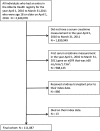Emergency Department Use among Patients with CKD: A Population-Based Analysis
- PMID: 28119410
- PMCID: PMC5293336
- DOI: 10.2215/CJN.06280616
Emergency Department Use among Patients with CKD: A Population-Based Analysis
Abstract
Background and objectives: Although prior studies have observed high resource use among patients with CKD, there is limited exploration of emergency department use in this population and the proportion of encounters related to CKD care specifically.
Design, setting, participants, & measurements: We identified all adults (≥18 years old) with eGFR<60 ml/min per 1.73 m2 (including dialysis-dependent patients) in Alberta, Canada between April 1, 2010 and March 31, 2011. Patients with CKD were linked to administrative data to capture clinical characteristics and frequency of emergency department encounters and followed until death or end of study (March 31, 2013). Within each CKD category, we calculated adjusted rates of overall emergency department use as well as rates of potentially preventable emergency department encounters (defined by four CKD-specific ambulatory care-sensitive conditions: heart failure, hyperkalemia, volume overload, and malignant hypertension).
Results: During mean follow-up of 2.4 years, 111,087 patients had 294,113 emergency department encounters; 64.2% of patients had category G3A CKD, and 1.6% were dialysis dependent. Adjusted rates of overall emergency department use were highest among patients with more advanced CKD; 5.8% of all emergency department encounters were for CKD-specific ambulatory care-sensitive conditions, with approximately one third resulting in hospital admission. Heart failure accounted for over 80% of all potentially preventable emergency department events among patients with categories G3A, G3B, and G4 CKD, whereas hyperkalemia accounted for almost one half (48%) of all ambulatory care-sensitive conditions among patients on dialysis. Adjusted rates of emergency department events for heart failure showed a U-shaped relationship, with the highest rates among patients with category G4 CKD. In contrast, there was a graded association between rates of emergency department use for hyperkalemia and CKD category.
Conclusions: Emergency department use is high among patients with CKD, although only a small proportion of these encounters is for potentially preventable CKD-related care. Strategies to reduce emergency department use among patients with CKD will, therefore, need to target conditions other than CKD-specific ambulatory care-sensitive conditions.
Keywords: Adult; Alberta; Ambulatory Care; Canada; Emergency Service, Hospital; Epidemiology and outcomes; Follow-Up Studies; Humans; Hyperkalemia; Hypertension, Malignant; Renal Insufficiency, Chronic; chronic kidney disease; dialysis; heart failure; hospitalization; renal dialysis.
Copyright © 2017 by the American Society of Nephrology.
Figures



Comment in
-
Preventing Emergency Department Use among Patients with CKD: It Starts with Awareness.Clin J Am Soc Nephrol. 2017 Feb 7;12(2):225-227. doi: 10.2215/CJN.12881216. Epub 2017 Jan 24. Clin J Am Soc Nephrol. 2017. PMID: 28119411 Free PMC article. No abstract available.
References
-
- Drey N, Roderick P, Mullee M, Rogerson M: A population-based study of the incidence and outcomes of diagnosed chronic kidney disease. Am J Kidney Dis 42: 677–684, 2003 - PubMed
-
- Eknoyan G, Lameire N, Barsoum R, Eckardt KU, Levin A, Levin N, Locatelli F, MacLeod A, Vanholder R, Walker R, Wang H: The burden of kidney disease: Improving global outcomes. Kidney Int 66: 1310–1314, 2004 - PubMed
-
- Go AS, Chertow GM, Fan D, McCulloch CE, Hsu CY: Chronic kidney disease and the risks of death, cardiovascular events, and hospitalization. N Engl J Med 351: 1296–1305, 2004 - PubMed
-
- Hemmelgarn BR, Manns BJ, Lloyd A, James MT, Klarenbach S, Quinn RR, Wiebe N, Tonelli M; Alberta Kidney Disease Network : Relation between kidney function, proteinuria, and adverse outcomes. JAMA 303: 423–429, 2010 - PubMed
MeSH terms
Grants and funding
LinkOut - more resources
Full Text Sources
Other Literature Sources
Medical
Molecular Biology Databases
Research Materials
Miscellaneous

